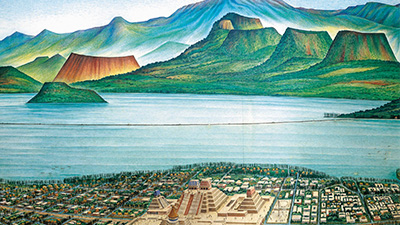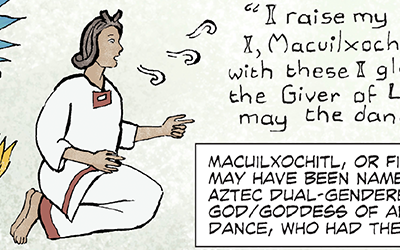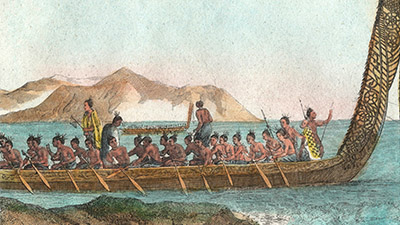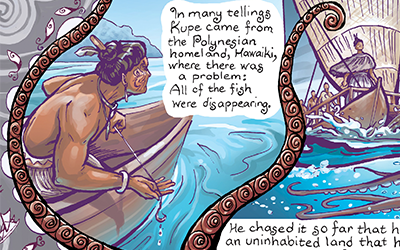Communities in the Americas and Oceania
Teacher Resources
Driving Question: How were communities organized in the Americas and Oceania?
From 1200 to 1450 CE, the Americas and Oceania were both large geographic regions in which complex societies were connected by expansive networks of exchange. In this lesson, you will explore a variety of communities that existed during this period, which will help you make historical comparisons across both time and space.
Learning Objectives:
- Understand how Indigenous communities in the Americas and the Pacific were organized and how these communities interacted with each other.
- Understand the similarities and differences between societies that developed in Oceania and the Americas.
- Use a graphic biography to support, extend, or challenge the overarching narratives of this period.
Vocab Terms:
- empire
- hierarchy
- migration
- polytheistic
- ritual
- society
- state
Opener: Communities in the Americas and Oceania
To teach this lesson step, refer to page 2 of the Lesson 2.6 Teaching Guide.
Ever been stumped by a question? Sometimes it’s less about not knowing the answer to the question than it is about understanding the question in the first place!
Communities of the Americas
To teach this lesson step, refer to page 3 of the Lesson 2.6 Teaching Guide.
Make sure all your students are able to engage with each part of lesson step. Check out the OER Project Differentiation Guide to help you make materials accessible to all.
Communities in the Americas developed into a diverse tapestry of states, empires, chiefdoms, and tribal systems. Use the article, video, and graphic biography below to explore how these societies emerged and evolved. Then, describe these communities from the perspective of an explorer.
-
Guiding Questions
-
Before you read
Preview the questions below, and then skim the article. Be sure to look at the section headings and any images.
While you read
Look for answers to these questions:
- What type of state was Haudenosaunee? How was it governed?
- What type of state was the Aztec state? How was its diverse population ruled?
- What evidence is there of connections between the Aztec society and Mayapan?
- What kind of a state was the Inca state? How was it governed?
After you read
Respond to these questions: How do societies in the Americas seem distinct from those in other regions you have studied? Are there any major similarities that these communities shared with those in other regions?
-
Guiding Questions
-
Before you watch
Preview the questions below, and then review the transcript.
While you watch
Look for answers to these questions:
- How does the story of the Ancestral Pueblo challenge traditional world-historical narratives about agriculture and complex societies?
- How does Theresa Pasqual characterize Pueblo origin stories?
- Why are these origin stories important today?
- What are some strategies that Pueblo people used to thrive on the Colorado Plateau?
- How does Theresa Pasqual describe the movement of the Ancestral Pueblo people?
After you watch
Respond to these questions: What do you think are the differences between what we can learn from archaeology and what we can learn from oral traditions? What do you think historians should do when the two types of evidence disagree?
Key Ideas
-
Guiding Questions
-
Before you read
Preview the questions below, and then skim the comic, paying attention to things like prominent colors, shapes, and types of text and fonts. How do you know where to start and in which direction to read? What’s in the gutters (the space between panels)? Who or what is the focus of the comic?
While you read
- Who was Macuilxochitl and how does she describe herself?
- Macuilxochitl describes the Tenochtitlan (Aztec) conquest of Tlacotepec as “forays for flowers [and] butterflies.” What does this mean?
- Macuilxochitl writes that Axayacatl spared the Otomi warrior in part because he brought a piece of wood and deerskin to the ruler. What does this tell you?
- How does the artist use art and design to emphasize and demonstrate the importance of tribute?
After you read
Respond to this question: How does this biography of Macuilxochitl support, extend, or challenge what you have learned about the Aztec state and economy in Mesoamerica in this period?
Communities of Oceania
To teach this lesson step, refer to page 5 of the Lesson 2.6 Teaching Guide.
Want to know even more about Oceanic history? This blog post outlines how much history has happened off land!
Imagine living among thousands of islands. How would you connect with or get to know the people on the other islands? Somehow, the peoples of Oceania connected with each other across thousands of miles of open ocean.
-
Guiding Questions
-
Before you read
Preview the questions below, and then skim the article. Be sure to look at the section headings and any images.
While you read
Look for answers to these questions:
- How do historians believe that humans ended up settling the islands of Oceania? What debate surrounds this question?
- What were the most important innovations that allowed migrations across Oceania?
- In general, how did communities in this region organize themselves?
- What were gender relations like in Oceania societies?
- What evidence is there to show that Oceania was not separated from the rest of the world?
After you read
Respond to these questions: The production and distribution frame narrative asserts that humans have grown more sophisticated in the way we make and use the things we need over time. Does the evidence presented in this article support, extend, or challenge this narrative? How?
-
Guiding Questions
-
Before you read
Preview the questions below, and then skim the comic, paying attention to things like prominent colors, shapes, and types of text and fonts. How do you know where to start and in which direction to read? What’s in the gutters (the space between panels)? Who or what is the focus of the comic?
While you read
- Who was Kupe?
- How is the story of Kupe normally told in Polynesian society? How have European historians tried to tell it?
- Why is this story important for the Māori people today?
- How did the artist use art and design to demonstrate the theme of connectedness?
After you read
Respond to this question: What does this graphic biography suggest about the different ways that history is used?
Closer: Communities in the Americas and Oceania
To teach this lesson step, refer to page 7 of the Lesson 2.6 Teaching Guide.
Interested in how other teachers have approached Oceania and the Americas? Take a look at this conversation in the OER Project Teacher Community.
Illustrate what you’ve learned about communities in this lesson.
Empires in Mesoamerica
To teach this lesson step, refer to page 7 of the Lesson 2.6 Teaching Guide.
The Aztec Empire was the most powerful state in Mesoamerica, but it took work to stay in power. Find out how conquests and tribute made the Aztecs a force to be reckoned with.
-
Guiding Questions
-
Before you watch
Preview the questions below, and then review the transcript.
While you watch
Look for answers to these questions:
- What did Aztec society have in common with ancient Greece?
- What was the Triple Alliance, and in what context did it develop?
- How did the system of city-states help Hernando Cortes conquer the Aztec Empire?
- How did Aztec and Maya political communities differ from each other?
After you watch
Respond to this question: How does the Aztec state compare to different types of Afro-Eurasian states and communities you’ve learned about?
Key Ideas
Extension Materials
To teach this lesson step, refer to page 8 of the Lesson 2.6 Teaching Guide.
Under the Inca’s Mit’a system, tribute and mandatory service resulted in magnificent monuments, roads, bridges, and other infrastructure projects.
-
Guiding Questions
-
Before you watch
Preview the questions below, and then review the transcript.
While you watch
Look for answers to these questions:
- Who was Pachacuti?
- What did the Inca call themselves? What did Inca mean?
- What made the Inca an empire?
- How many people were living in the Inca Empire prior to its decline?
- What was the Mit’a system?
After you watch
Respond to this question: What are the differences and similarities between the Mit’a system of production and distribution and those of Afro-Eurasia during this era?








